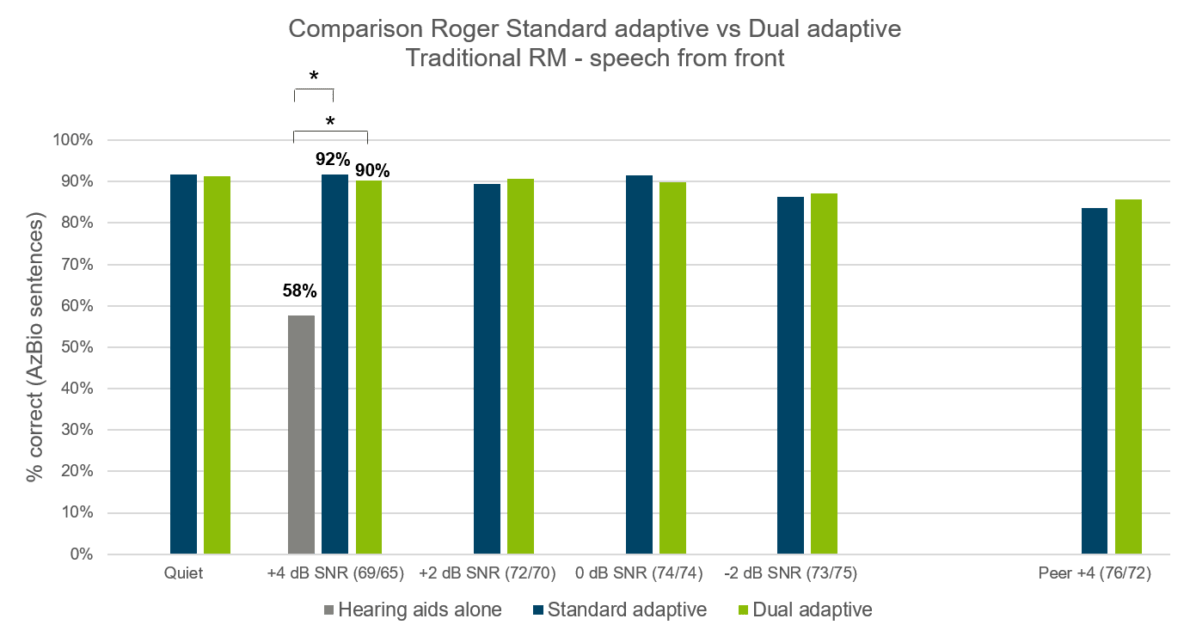
Personalize your Roger™ fittings for kids
With the new Dual adaptive feature in Target, you can give kids their preferred Roger setting for the classroom. Audiologist Jodie Nelson shares recent research that identifies which kids can benefit from it.
If you’ve been into the program options section of the RogerDirect + mic in Target you would have likely seen the option to set Roger’s adaptive microphone behavior as either Standard (default) or Dual.
Have you ever changed it to Dual? Have you wondered which clients would benefit from the switch? First, it’s important to understand the difference the two features.
What is the difference between Standard and Dual settings?
We know one of the advantages of a Roger™ microphone system is that it adapts to the amount of background noise in the environment. As the background noise level increases, so does the level of the Roger signal. This is how Roger maintains a positive and beneficial SNR even when the noise is loud.
This is true for both the Standard adaptive and Dual adaptive settings. But how the two adaptive microphone methods get there is different.
- For Standard, it does this by increasing the level of the Roger signal only.
- For Dual, it does this by a combination of increasing the Roger signal and attenuating the hearing aid microphone signal dependent on the noise level.
What is the expected benefit of Dual?
Well, the SNR is equal for both methods regardless of the level of background noise so we would expect that the hearing performance would also be equal.
But because with Dual the SNR is maintained through a combination of increased Roger signal and attenuation of the hearing aid signal, it is possible that some Roger users will find Dual to be more comfortable than Standard.
What does the research say?
Jace Wolfe and colleagues conducted a study with 25 children who were experienced hearing aid users.1 Twenty-one of the 25 participants were experienced Roger users. The study found that speech discrimination scores were, on average, 32 percentage points better with dual adaptive compared to hearing aids alone at +4 dB SNR and there was no significant difference in performance when comparing standard and dual adaptive microphone behavior at any of the SNRs tested.

When the kids were asked which they would choose, the combined environment results indicated a tendency toward Dual being favored over Standard. However, there wasn’t a significant difference. Keep in mind that the majority of participants were experienced Roger users (21/25) so they were used to the Standard setting. So, the question needs to be asked if their previous experience influenced their choice.
When should I consider Dual over Standard?
Dual can benefit certain children (and adults), including:
- New Roger users
- Children and adults who are more sensitive to loud sounds
- Children who have more limited headroom in their fitting
- Children who report feeling overloaded with sound by the end of the day
Ask these two questions to choose the right option
To guide you in personalizing Roger fittings for the kids in your practice, here are a couple of questions to ask when setting this feature in Target.
- Is this a new fitting? If so, consider starting with Dual.
- What is the Roger user saying? Any indication that they are more sensitive to loud sounds could indicate that Dual is the better setting for them.
To learn more about this study, I invite you to read an article in the Journal of Educational, Pediatric & (Re)Habilitative Audiology here.
Reference
Wolfe, J., Neumann, S., Schafer, E., Towler, W., Miller, S., Dunn, A., Jones, C. & Nelson, J. (2021). Evaluation of a dual adaptive remote microphone system. Journal of Educational, Pediatric & (Re)Habilitative Audiology; 25, 3.

